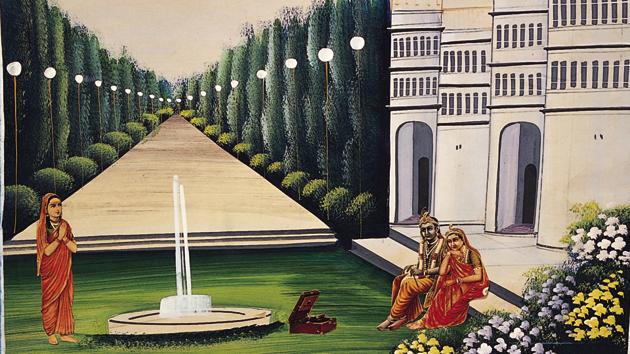An exhibition features historic prints and posters from the early 19th century
Infant Krishna with a Biblical halo, a woman posing with a tennis racket — an exhibition decodes the significance of colonial prints
In popular folklore, Krishna’s mother, Devaki, gave birth to him in a dark jail cell, where she was imprisoned by her brother, Kamsa. Yet, an 1880 painting depicts the birth of Krishna as similar to that of Jesus Christ — there is a halo over Krishna, as Devaki holds him up in her arms. The print bears the mark of Chore Bagan Art Studio, Calcutta. The studio produced scores of Hindu mythological images with hybrid aesthetics in the late 19th century. The advent of modernity is seen in another print where Krishna is sitting with Radha, enjoying music from a gramophone. Traditionally depicted as a flautist, here Krishna is seen as an everyday man, listening to music with his consort.

The European features and distortion to the traditional imagery notwithstanding, the prints by Chore Bagan, and those by artists like Raja Ravi Varma and his printing press, Ravi Varma Lithographic Press, marked a turning point in India’s relationship with religion. It also normalised the supernatural.
Read more: Check out these 10 vintage prints from the pre-Independence era
“The mass-produced printed visuals that depicted religious and mythological imagery brought about a major change in the very nature of worship in India. It democratised religious images and expanded their accessibility,” says Dr Jyotindra Jain, director and managing trustee of the Centre for Indian Visual Culture, New Delhi.

To showcase this notable shift, Jain is curating an exhibition titled Indian Popular Visual Culture: The Conquest of the World as Picture. It features posters, print ads and film posters from the 19th century, and explores the mass-produced visual material of the colonial era to gauge its impact on contemporary social values.
The exhibition also highlights the consequences of mass accessibility of religion. Case in point, the juxtaposition of religious prints with messages of independence and patriotism in colonial India. “Images depicting Rama as an ideal king, and portraits of Shivaji with his guru Ramdas were popularly used during the freedom struggle. The printed images of goddesses Lakshmi and Saraswati by Raja Ravi Varma in the last quarter of the 19th century, in a way, served as models for the later images of Bharat Mata [Mother India],” says Jain.

Read more: Artist Rekha Rodwittiya’s artwork relooks at feminine symbolism
The posters and print ads also factored in the aspirations of a young Indian society that married traditional Indian values with colonial modernisation. For instance, the poster of a woman on a tennis court is representative of social change, with outdoor spaces traditionally dominated by men. “It denotes the transition from tradition to modernity,” says Jain.
BE THERE: Indian Popular Visual Culture: The Conquest of the World as Picture will be on display from April 8 till April 30, at Dr Bhau Daji Lad City Museum, Byculla.
Call: 2373 1234





